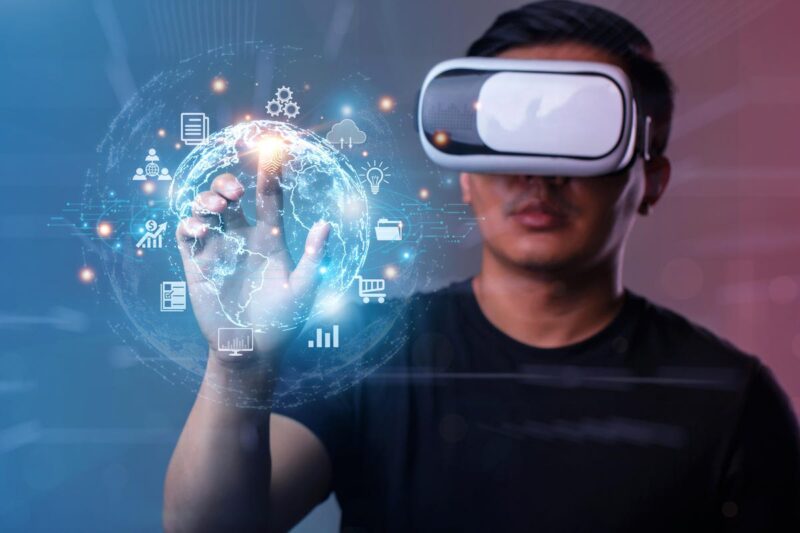Are you ready to enter a virtual world where you can meet individuals from all over the world and have genuine conversations with them? How we live, learn, and socialise will all be affected by the upcoming technological revolution known as the Metaverse. But what materials will we need to construct this utopia of the future? This article explores What Technology is Necessary to Create the Metaverse?
What Technology is Necessary to Create the Metaverse?
Important technologies that provide natural user-user and user-environment interactions include virtual reality platforms, 3D modelling tools, network technologies, development platforms, and AI/ML systems.
With the help of VR platforms, users may move freely around a 3D world and manipulate virtual items. Images of objects, characters, and locations can be made to look photorealistic with the help of 3D modelling software.
Players can communicate and work together on projects thanks to networking technologies. Platforms for software development equip programmers with the resources they need to build programmes and video games for the metaverse. Computer-controlled characters’ replies and actions are made to appear more natural through the application of AI and machine learning. Together, these technologies produce a surreal environment that feels real to the user.
Artificial Intelligence is shorthand for this concept.
The upcoming Metaverse will be an extremely advanced form of virtual reality. To achieve this level of realism, the Metaverse will need to be constructed using AI-powered virtual beings that are indistinguishable from humans.
They need to have natural conversations, show feelings, and work with people. Making AI-powered virtual humans look and act like actual people is a major hurdle for developers of the Metaverse.
Synthetic Realism (VR)
In order to construct the Metaverse, virtual reality (VR) technology is essential. The Metaverse is an imagined merged virtual reality comprising all current online societies and MMOs. Accessible to anyone with an internet connection, it would let users engage in lifelike, three-dimensional interactions.
Virtual reality hardware like the Oculus Rift, HTC Vive, and PlayStation VR is already on the market. Users can be whisked away to fantastic new worlds with the help of these platforms. But, the Metaverse cannot be built without significantly more sophisticated VR technology.
This new virtual reality technology must be able to accommodate a large number of users at once while still delivering an experience that is both realistic and believable. It also has to be open source and simple to use for programmers so that they may build the varied virtual environments that will make up the Metaverse.
Companies like Magic Leap, JauntVR, and 8i are developing state-of-the-art virtual reality systems. However the Metaverse comes into existence, virtual reality technology will undoubtedly play a key part.
Augmented Reality, or AR
Virtual objects can be placed in a user’s real-world environment and interacted with using augmented reality. The uses for augmented reality are not limited to the entertainment and gaming industries.
With the use of augmented reality, we may superimpose digital data on top of our actual surroundings. A user could, for instance, observe an overlay with traffic data as they made their way home, or they could point their phone at a building to learn more about the businesses housed within. The terms “augmented reality” and “mixed reality” are commonly used to describe this sort of AR.
Likewise, augmented reality can be utilised to build wholly engrossing simulated environments. When participating in this form of augmented reality, participants don headsets that render the physical environment irrelevant. The term “virtual reality” is often used to describe this kind of augmented reality (VR).
The New Blockchain Technology and Digital Currencies
The Metaverse is a blockchain-powered virtual universe. Currency in the Metaverse is cryptographic tokens. With blockchain technology, a distributed ledger of all Metaverse transactions can be created. This ledger is decentralised, open source, and completely transparent. Cryptocurrencies are accepted as means of payment in the Metaverse.
In the Cloud, Precisely
Computers and other devices can get data and processing power from remote servers whenever they need it thanks to cloud computing. It’s a way for users to connect to a shared pool of flexible computing resources over the internet whenever they need to (e.g., networks, servers, storage, applications, and services). There are five main components to this cloud architecture, as well as three service models and four deployment strategies.
Connectivity Protocols
The internet wouldn’t be possible without the networking protocols that allow devices to talk to one another. TCP/IP, UDP, and HTTP are only a few of the many protocols available today.
Since people and gadgets in the Metaverse will be exchanging vast volumes of data with one another, the system will need its own networking protocol. The current protocols need to be improved or changed since they cannot handle the increased load.
Conclusion
As interest in the Metaverse grows, it is more important than ever to grasp the technology behind it. Immersive hardware and software, cloud services, artificial intelligence algorithms, data analytics instruments, and network security protocols are just a few of the key elements that have been covered. Now that we have all of these resources, we can start building a digital area where people from all over the world may interact in real time with one another. This was all about What Technology is Necessary to Create the Metaverse?

